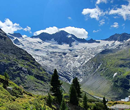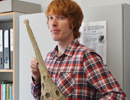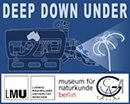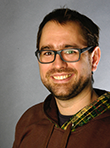Research Projects
Current Projects
AlpSenseRely
Alpine remote sensing of climate‐induced natural hazards

AlpSenseRely is a three-year research project focussing on the development of an early warning system for natural hazards in particularly climate-sensitive alpine areas. It makes an important contribution to risk reduction and, due to its preventive character, to cost reduction of climate-related natural hazards. AlpSenseRely is a joint project of TUM, LMU, BAdW, FAU and 3DR, financed by the Bavarian State Ministry of the Environment and Consumer Protection.
GeoBio-Center Member Prof. Florian Siegert is Co-PI of the AlpSenseRely subproject Multi-scale remote sensing and 3D visualisation, which is joined by Ms. Natalie Barbosa as PhD student.
Source and further reading (in German): https://www.bgu.tum.de/landslides/alpsense/projekt/
Marie Skłodowska-Curie Innovative Training Network "Comparative Genomics of Non-Model Invertebrates" (IGNITE)

Press release: Exploring invertebrate genomes
IGNITE-Comparative Genomics of Non-Model Invertebrates
Dr. Sebastian Höhna joins the GeoBio-Center as a DFG Emmy Noether Junior Research Group Leader
Development of new statistical models and computational methods to answer research questions in phylogenetics, which include:
(1) Estimating phylogenetic relationships;
(2) Estimating divergence times and rates of molecular evolution;
(3) Inferring rates and mode of lineage diversification (speciation and extinction);
(4) Analyzing causes of conflicting gene trees.
Contact person: Dr. Sebastian Höhna
Sponge Barcoding Project
 The phylum Porifera (sponges) consists of about 8,000 described species, with an estimated species number of more than 15,000. The Sponge Barcoding Project (SBP) aims to cover all sponge taxa, from classes Demospongiae, Hexactinellida, and Calcarea, and ranging in habitat from the marine intertidal to the deep-sea, as well as freshwater. Obtaining DNA-signature sequences from 8,000 taxa will provide a platform from which more extensive sampling can be directed. Recently described type specimens curated in associated museums are barcoded first and supplemented with unequivocally identifiable taxa.
The phylum Porifera (sponges) consists of about 8,000 described species, with an estimated species number of more than 15,000. The Sponge Barcoding Project (SBP) aims to cover all sponge taxa, from classes Demospongiae, Hexactinellida, and Calcarea, and ranging in habitat from the marine intertidal to the deep-sea, as well as freshwater. Obtaining DNA-signature sequences from 8,000 taxa will provide a platform from which more extensive sampling can be directed. Recently described type specimens curated in associated museums are barcoded first and supplemented with unequivocally identifiable taxa.
Contact person: Prof. Dr. Gert Wörheide
Website: www.spongebarcoding.org
Past Projects
Dr. Richard Butler joins the GeoBio-Center as a DFG Emmy Noether Junior Research Group Leader
 He gained his Ph.D in 2007 from the University of Cambridge and has since worked as a researcher at the Natural History Museum (London) and the Bayerische Staatssammlung für Paläontologie und Geologie. His research team will focus on the early evolutionary radiation and rise to ecological dominance during the Triassic (250–200 million years ago) of Archosauromorpha, a major group of vertebrates that include birds, crocodiles, dinosaurs and pterosaurs. They will also examine the impact of the major mass extinctions at the Permian/Triassic and Triassic/Jurassic boundaries in driving this radiation. The research team will initially consist of Dr. Butler and two Ph.D students, and will use cutting edge morphological and analytical approaches, such as microCT scanning and web-based morphological databases, to address outstanding taxonomic and phylogenetic questions. Moreover, the team will use quantitative techniques to analyse and model macroevolutionary and biogeographical patterns, including changes in taxonomic and morphological diversity and body size evolution. This research program will involve collaborations with researchers in Europe, the USA, South America, China and Russia, and will be linked with an ongoing field program co-led by Dr. Butler in the Triassic of Portugal.
He gained his Ph.D in 2007 from the University of Cambridge and has since worked as a researcher at the Natural History Museum (London) and the Bayerische Staatssammlung für Paläontologie und Geologie. His research team will focus on the early evolutionary radiation and rise to ecological dominance during the Triassic (250–200 million years ago) of Archosauromorpha, a major group of vertebrates that include birds, crocodiles, dinosaurs and pterosaurs. They will also examine the impact of the major mass extinctions at the Permian/Triassic and Triassic/Jurassic boundaries in driving this radiation. The research team will initially consist of Dr. Butler and two Ph.D students, and will use cutting edge morphological and analytical approaches, such as microCT scanning and web-based morphological databases, to address outstanding taxonomic and phylogenetic questions. Moreover, the team will use quantitative techniques to analyse and model macroevolutionary and biogeographical patterns, including changes in taxonomic and morphological diversity and body size evolution. This research program will involve collaborations with researchers in Europe, the USA, South America, China and Russia, and will be linked with an ongoing field program co-led by Dr. Butler in the Triassic of Portugal.
Deep Down Under
 In close collaboration with Project Deep Ocean Australia & the Queensland Museum (Brisbane, Australia)
In close collaboration with Project Deep Ocean Australia & the Queensland Museum (Brisbane, Australia)
Exploration of relict faunas at Osprey- and Shark Reefs (Queensland Plateau, Coral Sea, Australia)
An exceptional sessile invertebrate fauna was discovered in the 1970s on the Norfolk Ridge in the SW Pacific. This fauna is remarkable because it contains populations of animals that were previously thought to be extinct but have persisted almost unchanged on the deep reef slopes since the late Mesozoic (>65 MYA).
Contact person: Prof. Dr. Gert Wörheide
Forest restoration and rehabilitation in Southeast Asia FORRSA
 The project aims at the human capacity enhancement of Asian and European young academics and postgraduate students for teaching and research on restoration and rehabilitation of degraded forests and wetlands in Southeast Asia, specifically Indonesia and Thailand.
The project aims at the human capacity enhancement of Asian and European young academics and postgraduate students for teaching and research on restoration and rehabilitation of degraded forests and wetlands in Southeast Asia, specifically Indonesia and Thailand.
Contact person: Prof. Dr. Florian Siegert
Restorpeat
The project aims at research and development of new methods on the sustainable restoration of disturbed tropical peatlands and peat swamp forest ecosystems.
Contact person: Prof. Dr. Florian Siegert
Huinay, Chile
In cooperation with the research station ‚Huinay’ of the Chilean Fundacion Huinay (http://www.huinay.cl) three members of the GeoBio-Center of LMU Munich (GBC) spent two months in Huinay/Chile in early 2007.
Past Projects
For further details on past projects of the GeoBio-CenterLMU please see our Biennial Reports.


